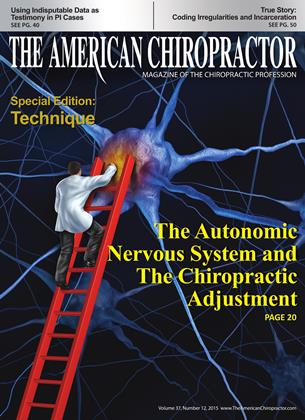Explaining Laser Classifications
TECHNIQUE
By Mike Mathesie, DC, DACRB, DABFP, and Rob Berman, MBA
Many laser companies are marketing their lasers based upon the laser’s classification as a proxy for power. The concept is that Class 4 lasers are “high power,” and the other classifications are “low power.” We believe that the marketing message is distorting the intended purpose of the laser classifications. The FDA established the classification system primarily to indicate the risk of injury to the eyes.
Figure 1 is our tongue-in-cheek take on the whole “scary” marketing message, (www.electricstuff.co.uk)
Big Scary Laser
Do not look Into bean with remaining eye
Let’s Take a Look at the Laser Classifications
Laser and LED Safety Classification1
Class 1
Safe under reasonable operation.
Class 1M
Generally safe; some precaution required.
Class 2
lmW average power; visible light low power; blink response limits risk.
Class 2M
UV or IR light at low average power; generally safe LED systems.
Class 3R(A)
Safe for viewing with the unaided eye.
Class 3a
1 to 5mW of average power.
Class 3b
5 to 500mW of average power; viewing beam is hazardous; diffuse reflections are safe.
Class 4
>500mW average power all the way up to industrial megawatts; hazardous under all conditions to eyes.
NOTE: BASED ON SAFETY, NOT CLINICAL PERFORMANCE
Laser Safety Classification Explained
Following are our less technical explanations for the laser classifications:
• Class 1 : Low-power lasers incapable of causing eye damage that are exempt from any control measures. Example is a barcode reader. Safety goggles are not required.
• Class 2: Low-power lasers that operate in the visible spectrum that are incapable of causing eye damage unless they aie viewed directly for an extended period (greater than 1,000 seconds). Examples are laser pointers and LEDs. Safety goggles are not required.
• Class 3a: Lasers that normally would not produce a hazard if viewed for only momentary periods (0.25 seconds) with the unaided eye (blink reflex). They may present a hazard if viewed using collecting optics. Safety goggles aie required.
• Class 3b: Lasers that can produce a hazard if viewed directly. This includes intrabeam viewing of specular reflections. Many low-level lasers or “LLLT” lasers fall into this category. Safety goggles are required.
• Class 4: Lasers capable of causing severe eye damage with short-term duration (0.25 seconds) exposures to direct, specularly reflected, or diffusely reflected beams. Safety goggles are required. (Please remember that Class 4 therapy lasers are different from Class 4 surgical lasers.)
Reflection and Deflection
Eye protection is required for Classes 3a, 3b, and 4, even if the laser is not aimed at a patient’s or staff member’s eyes because there is a risk of reflection or deflection off a metal or mirrored surface (Figure 2).
Remember, the blink Ultraviolet Visible spectrum Infrared
reflex works only for visible light. The deep penetrating therapeutic wavelengths are in the infrared spectrum. However, manufacturers often include a red aiming beam so that the doctor or staff member can see where the
laser is pointed. Figure 3 illustrates ultraviolet, visible spectrum, and infrared wavelengths as measured in nanometers (nm).
Understand and Mitigate the Risk
Several therapy procedures have possible risk, such as the possibility of surface burns from hot packs or from electrical stimulation if it’s not properly applied. Ultrasound treatments can result in periosteal bums.
Some lasers do pose a risk to eyes if improperly used without safety goggles. In our experience, the following two simple techniques mitigate the risk:
1. Close the door to the treatment room or close the curtain around the treatment table.
2. Everyone present in the treatment area absolutely must weai' safety goggles rated for the specific wavelengths utilized by the laser.
References:
1. American National Standard Institute (AMSI) Safe Use of Lasers in Health Care Facilities ANSI Z136.3-2011.
tDr. Michael' Mathesi e has practiced in Coral Springs, Florida for 25 years. He has taught and utilized laser therapy in his practice since 2005. During that time, he attained board certifications from the American Chiropractic Rehabilitation Board (DACRB) and the American Board of Forensic Professionals (DABFP), which are both recognized specialty boards of the American Chiropractic Association. Dr. Mathesie has been bestow edwith the Sports Chiropractor of the Year Award, the Broward County Chiropractor of the Year Award, and the DOH Distinguished Sen’ice Awardfrom his peers. Two governors have appointed him to the Florida Board of Athletic Training and the Florida Board of Chiropractic Medicine. He has lecturedfor his profession in many postgraduate subjects and also hada clinical case study paper accepted for publication in the peer-reviewed Journal of the North American Rehab Specialist. He can be reached at 954-755-1434.
Rob Berman, MBA, is a partner at Berman Partners, LLC, a medical device sales, service, and marketing company. Berman Partners specializes in new andpreowned therapeutic lasers. Rob helps doctors improve patient outcomes while increasing physician income. He has held a variety of marketing roles during his career, which includes building and managing a marketing department, directing product development and product management for multiple organizations, and serving as general manager for a variety of business units. Rob can be contacted by phone at 860-707-4220 or by email at robfrbermanpartners.com. His company’s website for new lasers is www.bermanpartners.com, and the website for used lasers is www.usedlasercenter.com.
 View Full Issue
View Full Issue






